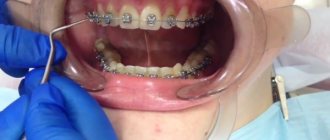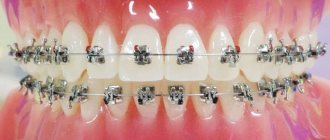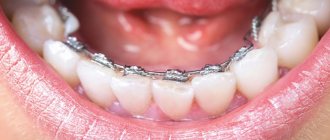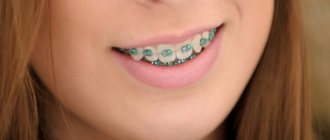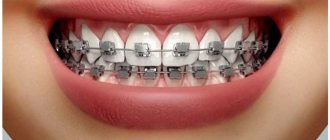Needless to say, sapphire or ceramic braces look great. But they deal a very noticeable blow to the family budget.
Is there a less expensive way to correct the position of teeth while maintaining maximum aesthetics? Yes, this option is possible, and its name is combined braces.
General information
Combined braces are orthodontic devices that have at least one of the following features:
- The systems are made of different materials.
- Fastening is carried out both outside the dentition (vestibular) and inside (lingually).
- One system combines ligature and self-ligating types of arch fixation.
The goal of using combination braces is to reduce the cost of treatment while maintaining high esthetics and effectiveness.
Basic principles for installing combined devices:
- Aesthetic options for braces are placed on the front (front) teeth - sapphire or ceramic.
- Metal locks are installed on the chewing rows.
- Metal models can be installed on the lower jaw (not only on the lateral teeth, but also on the front teeth), since they are less visible when opening the mouth than the upper teeth.
- Lingual braces are used on the upper jaw, and vestibular braces on the lower jaw.
Combined braces - what are they and why?
Combined braces are an orthodontic brace system made from 2 different materials. Its task is to allow the patient not to pay for beauty where no one will see it. Aesthetic braces will be invisible in the smile area, but on the sides the patient needs the reliability of the metal.
We combine what with what
Various materials, including precious ones, are used to correct the bite. But the most popular are 3 types:
- Metal braces systems. Maximum reliability at the lowest price. However, these are the most visible type of braces. Some patients put off orthodontic treatment for years for fear of looking less attractive for a whole year.
- Sapphire. Transparent crystals are not visible on the teeth, only a thin arch remains. However, due to their lower strength, they are more demanding on the diet. The cost of treatment is high.
- Ceramic. White ceramics blends with the color of natural teeth. High efficiency, average cost.
Go well with:
- Metal+ceramics. The most popular and durable option.
- Metal+sapphire. Stealth is better, but the price is also higher.
Important: in a combined braces system, all braces must be ligature or all non-ligature.
Best combinations
Photos of combined braces in order from inexpensive to most aesthetically pleasing:
1. Better savings
Ligature system. 6K on the upper jaw, the rest are metal
2. Compromise option
Ligature system. 6K on both jaws. The rest is metal.
3. Very convenient
Non-ligation system. On the upper jaw 6K+6M, on the lower jaw metal
4. Maximum aesthetics
Self-ligating system, on the upper jaw 10K+2M, on the lower jaw 6K+6M
The mirror will tell you which option to choose. Smile and count how many of your teeth you can see. Do not take into account those where only the cutting edge is visible: the bracket is placed approximately in the middle of the tooth, and 2-5 mm remains to the edge. You have received the required number of aesthetic braces.
Price
First of all, the difference in the cost of braces, that is, the structures themselves, is visible, without taking into account the work of the doctor. The cost of a simple metal bracket is 3-8 times lower than a ceramic one and 6-12 times lower than a sapphire one. There are many manufacturers, hence the wide range in prices.
The cost of installing a combined and fully aesthetic brace system is the same. But if orthodontic treatment is planned on both jaws, and there are only metal braces on the lower jaw, the total cost of the work will be approximately 20% lower.
Let's calculate using an example
Prices in CosmoStom dentistry for September 2019 are used.
Ceramic. One of the most inexpensive aesthetic bracket systems, Reflections2, for 2 jaws with installation will cost about 67 thousand rubles (system x2 + installation x2).
Combined. When smiling, the patient reveals the 6 front upper teeth. For them we choose the same Reflections2, and for the remaining teeth we choose the Marquis metal bracket system from the middle price category. We count: 6 ceramic braces + 4 metal + Marquis system for the lower jaw + installation of a combined system + installation of a metal system. It turns out 48 thousand rubles.
Savings: 19 thousand rubles.
Metal. A proven and reliable Marquis brand for 2 jaws (x2 system + x2 installation) will cost 34 thousand rubles. Difference with combined: 14 thousand rubles. We emphasize that in terms of the duration and effectiveness of treatment, this option is in no way inferior to the previous two, the only difference is that it is invisible on the teeth.
Depending on the clinical situation, the patient may require other elements (arcs made of various alloys, springs, etc.), but their cost is low and does not depend on the type of system. The doctor decides on the need for their use, and in the treatment plan agrees with the patient on the final cost.
Savings may be greater or less depending on the width of your smile and the brand of braces. Consult your doctor which manufacturer is best to choose in your case.
Reviews from doctors about combined braces
Mertz Ksenia Evgenievna, orthodontist:
It is better to correct an incorrect bite than not to correct it due to price or high aesthetic requirements. Combined braces are a good compromise option, optimal in terms of price/invisibility. The patients are satisfied, the doctor is comfortable, the treatment time is not extended.
Krechkivskaya Oksana Aleksandrovna, orthodontist, teacher of the department of Omsk State Medical Academy:
A very popular option among young people. Older patients can usually afford the best aesthetics financially. Or they understand the need for treatment at the expense of beauty, especially since it is temporary. As a doctor, I would like to add that combined systems remain less noticeable only with good hygiene. Even the most expensive braces with stuck food residues look worse than pure metal ones.
Kuznetsov Anton Alekseevich, orthodontist, author of the TRG analysis method:
Different materials apply different pressures on teeth, and working with the combined system requires special skill. But experience shows that treatment with combined braces is effective.
Advantages of the systems
The main advantage of combined products is the optimal combination of positive characteristics that various similar systems have.
This combination provides:
- cost-effectiveness of the system (some of the locks are made of inexpensive metal);
- good aesthetics (due to the use of ceramic or sapphire plates on the front teeth);
- high efficiency (due to the use of reliable and durable metal locks on the chewing teeth).
The disadvantages of combined models include the following features:
- reduced aesthetics compared to pure sapphire and ceramic products;
- less strength than purely metal devices;
- possible temporary deterioration of diction due to the complexity of the design;
- worse care conditions compared to similar systems;
- increased requirements for the qualifications of the dentist, who must have experience working with various types of systems.
Caring for combined brace systems
Mono-beam toothbrush Miradent, 4 replaceable heads
Even a conventional device designed to correct dental malocclusion requires careful care. What can we say about a combined system, in the design of which there is an interweaving of various types of materials.
For teeth, the main danger when wearing braces is caries. Due to the difficulty of high-quality cleaning of the oral cavity, often after eating food, food residues get stuck in the spaces between the brackets and the surface of the teeth.
Possible options
There are the following types of combined braces:
- lingual-vestibular;
- metal-ceramic;
- metal-sapphire;
- ligature-self-ligating.
Duet of the lingual and vestibular system
Combined lingual-vestibular devices are a system in which a system is placed on the upper jaw, attached from the inside of the dentition, and a vestibular type is fixed to the elements of the lower jaw arch (locks are located outside).
This solution allows you to achieve the optimal combination of price and aesthetics. Lingual braces are expensive, so pairing them with less expensive labial devices can reduce the overall price while maintaining acceptable esthetics.
Jaw material combination
The use of different materials on different jaws also makes combination systems more affordable.
A more aesthetic material (ceramics or sapphire) is placed on the upper jaw, and durable and inexpensive metal is placed on the lower jaw. Thanks to this, they reduce the overall cost of orthodontic treatment, while obtaining fairly good aesthetics and high reliability.
Tandem materials on one jaw
To fix the plates on one jaw, you can use different materials on the front and side teeth. Locks made of sapphire or ceramic are installed on the front elements, and metal on the chewing elements.
This allows you to reduce the cost of the system due to a slight reduction in appearance while maintaining the force of pressure on the entire jaw row.
Possible combinations of materials:
- metal (side teeth) + sapphire (front teeth);
- metal (lateral teeth) + ceramics (front teeth);
- ceramics (lateral teeth) + sapphire (front teeth).
Metal reinforcement
The most stressful part of the device is the groove in which the arc is located. Its walls work intensively for abrasion and compression.
To increase the strength of locks made of plastic, sapphire or ceramic, some manufacturers frame their grooves with stainless steel. This modified type approaches the strength of a purely metal device. At the same time, aesthetic properties deteriorate slightly.
Review of three models of Miso sapphire braces, features and purpose of the systems. Let's look at the design of Radiance braces here.
At this address https://dr-zubov.ru/ortodontiya/apparaty/brekety/vestibulyarnye/rezinki-malenkie-pomoshhniki.html you will find detailed information about the types of elastic bands for braces.
Possible combinations - their purpose
The combination of materials that will be used in a particular product depends on what tasks are assigned to the combined braces. The main and most common among them are the following.
A quick solution to the problem of malocclusion and curvature
If, due to various circumstances, a person needs to get rid of bite problems in a matter of months, he has to combine hard and dense materials in the device, which will have a strong impact on the teeth and straighten them as quickly as possible.
This will significantly reduce the time you wear braces, and the result will be decent.
The combination here is usually as follows. Plastic or ceramic plates are made for both jaws. They look beautiful and are easy to match the color of your teeth.
But where the arc is inserted, the entire structure is reinforced with metal. This creates more pressure on the jaw and teeth, which helps them straighten faster. True, there is one drawback here - the metal part slightly spoils the appearance of the product, but since the main goal is the fastest possible effect, you have to put up with it.
Correcting crooked lower teeth only
For a large number of people, only the lower teeth are crooked, while the upper jaw is in perfect order. In order not to load the upper row of teeth with conventional structures, while the lower row needs to be treated, it is convenient to use combined braces.
In this case, it is reasonable to use the following combination: for the upper row of teeth, some soft and aesthetically pleasing material is used, for example, the same plastic, but the lower teeth will be exposed to the metal part.
In this way, a dual goal is achieved - maintaining the normal appearance of the upper jaw and maximum therapeutic effect for the lower jaw.
Correction of minor deviations
When teeth are only slightly uneven, or the bite needs to be corrected just a little, then it is also wise to use combinations of materials.
For those teeth that are more visible and less crooked, plastic, sapphire or ceramic can be applied, while for others that are hidden in the depths of the oral cavity or require more correction, metal can be applied.
Reducing the cost of the system
Often this is the main goal for a large number of people who prefer combined braces. To achieve a reduction in the cost of treatment, but without losing efficiency, you can use combinations of the following options: install extremely high-quality and beautiful materials only on the front teeth (sapphire, ceramics), which are in plain sight; for the rest, use metal or other cheaper material.
This will help significantly save on the manufacture of braces. It is still best to use metal as a cheap material, since its cost is the lowest, and the effectiveness of its use is at a very high level.
These are the goals most often pursued when using combined systems.
Indications and contraindications
The goals of using combined braces differ somewhat between the doctor and the patient. The latter wants to solve his problem with minimal financial costs and maximum preservation of aesthetics. The doctor is more focused on the result of treatment.
In general, the following indications are available for combined braces:
- The patient’s desire to save money by installing economical metal braces on the side teeth (and sometimes on the lower front teeth), and sapphire or ceramic on the front teeth.
- The need for special adjustment of individual teeth or their groups due to the presence of specific factors. For example, a tooth needs to be moved over a long distance, which requires the use of strong and reliable metal locks.
With contraindications, the situation is more complicated, since, firstly, there are quite a lot of them, and secondly, some of them are relative, and some are absolute. The doctor must determine which contraindications are relative and which are absolute. The patient’s task is to inform the dentist in as much detail as possible about the state of his health.
The main contraindications for installation include:
- lack of supporting teeth;
- presence of dental diseases (you need to get rid of them before installing braces);
- allergy to components of the orthodontic system;
- some systemic somatic diseases (tuberculosis, diabetes mellitus, cancer, hematopoietic disorders, bone pathologies);
- impossibility for any reason to provide the braces with proper care;
- mental illnesses, including alcoholism and drug addiction;
- immunodeficiency states (AIDS, etc.);
- venereal diseases.
What is the essence of combined systems?
A combined bracket system is an orthodontic device that is made using two materials. Usually they combine metal with ceramics, artificial sapphires or composites. Why is this being done?
- Saving money. The use of metal instead of aesthetic materials significantly reduces the cost of combined braces.
- Increasing the effectiveness of the correction course. Modern materials, invisible on the teeth, are less dense and hard. They cannot always cope with the assigned tasks. Therefore, in some severe cases, the use of metal is indicated. But sometimes people become self-conscious about their smile with braces, especially if they often have to be the center of attention. Then the most visible areas of the system are made of aesthetic material.
How to make the braces system work effectively, but be invisible in real life and in photos? Let's look at a few examples of solving this issue.
Preparation and installation methods
Treatment with braces is a very serious undertaking that requires thorough preparation. Mistakes can be very costly.
Preparatory activities must include the following points:
- A conversation between a doctor and a patient , during which the dentist finds out the wishes of his client and introduces him to the essence of the procedure ahead of him.
- Physical and radiographic diagnostics , consisting of examination of the RP, radiography of teeth, study of anamnesis in order to identify contraindications to orthodontic treatment.
- Determining the treatment method and type of braces that would best suit the clinical situation.
- Orthodontic treatment, including the main and retention periods.
Installation of braces
There are two main methods of installing braces – direct and indirect. The first involves gluing clasps, one to each tooth in the patient’s mouth.
The second consists of making a special mouthguard with plates fixed in it. The mouthguard is placed over the teeth, as a result of which all the locks are installed at the same time.
Direct installation
The sequence of operations for direct installation is as follows:
- Cleaning tooth enamel. It is carried out with excavators and brushes using various cleaning materials (pumice, abrasive powders). After brushing for 10-15 seconds, the teeth are rinsed with a water jet under pressure.
- Installation of retractors and drying of teeth.
- Etching of tooth enamel. A special gel with orthophosphoric acid is used, which is applied to the enamel for 40-90 seconds (according to the instructions), and then removed - first with a cotton swab, then with a stream of water for 1 minute.
- Drying and applying bond to the enamel and base of the bracket, pressing the latter to the tooth, holding it pressed for about 20 seconds.
- Installation of the arc. The procedure begins approximately 10 minutes after the last bracket is attached.
The advantages of the direct method are the absence of preparatory operations for the manufacture of mouth guards, which are quite time-consuming and require special equipment.
Disadvantages include:
- the difficulty of positioning each bracket on a tooth in the oral cavity, which may result in errors in their location;
- the inability to see on a plaster model what the system looks like in its final position;
- the duration of the procedure for the patient, who must remain in the chair the entire time when the braces are installed one after the other in the oral cavity.
Indirect installation
As already noted, the operation involves the manufacture of a special mouthguard, with the help of which all braces are installed on the teeth at the same time. The sequence of procedures is as follows:
- An impression is made of the jaw.
- A plaster mold is made from the impression.
- Braces are installed on the form.
- The mold is made from thin plastic. The result is a product in which, like a packaging blister, all the braces are fixed, fixed exactly in the position in which they should be on the teeth.
- After appropriate preparation of the tooth enamel (as with direct installation) and smearing the teeth and braces with bonding agent, the tray is placed on the teeth. After removing it, all locks remain on the teeth in the desired position.
Advantages of the indirect method:
- eliminating doctor errors when positioning braces, which can occur with the direct method;
- short time and accuracy of system installation;
- comfort for the patient.
The disadvantages of the indirect method include the need to make a mouth guard, which in turn requires time and special equipment.
But, despite this, due to the accuracy and manufacturability of the indirect method, it is often preferred (subject to conditions).
The main advantages of Smart Clip braces and the material used in production. This post contains everything you need to know about Damon Clear ceramic braces.
Follow the link https://dr-zubov.ru/ortodontiya/apparaty/brekety/vestibulyarnye/clarity-v-borbe-za-idealnuyu-ulybku.html to get to know the Clarity brace system better.
Combined system from a medical and economic point of view
Why do doctors often advise using combined straightener options to correct a bite? It would be much more profitable for them to insist on purchasing more expensive braces - sapphire, for example, (as is what happens in a number of clinics and private offices). However, real specialists in the field will never use additional tricks just to attract more funds to their account or the account of the company for which they work. They will always be based on the wishes of the patient and the real picture of his health.
When an orthodontist suggests a combined type of bite corrector, he is usually guided by the following criteria:
- It is this system that best matches the client’s teeth type, i.e. with its help it is expected to obtain the most effective result and in the shortest possible time;
- combined braces, metal and ceramics or another productive combination will be able to cope with complex curvatures and will look aesthetically attractive;
- This option is convenient for the patient in terms of material expenses.
If we compare various possible combinations and the sapphire system, for example, it is often the braces proposed by the doctor that win, in which ceramic or other devices are used along with metal brackets.
Rules of care
Any orthodontic devices require careful care. It cannot be said that combined models in this sense are somehow different from similar products.
To maintain proper hygiene in the mouth, in addition to general brushing of teeth, it is necessary to pay attention to each brace individually, so a regular toothbrush needs to be supplemented with a wider range of tools.
It should include:
- single-tuft brush (with bristles collected in one bunch);
- dental brush;
- floss;
- irrigator for rinsing.
You need to spend more time brushing your teeth with braces than usual – preferably at least 5 minutes.
In addition to cleaning with brushes and brushes, you need to add rinsing with special solutions. Depending on the brand, they are endowed with many beneficial properties - aseptic, remineralizing, refreshing.
If the doctor deems it necessary, pastes and gels containing useful microelements (phosphorus, calcium, etc.) can be added to all this.
It is advisable for chewing gum lovers to give up their addiction, since the gum tends to stick to the elements of the brace system in the most inaccessible places. It is also necessary to exclude solid foods and coloring products (berries, coffee, red wine, etc.).
The video provides a patient's review of the wearing, comfort and effectiveness of combined braces, as well as care of the systems.
Price
Achieving beauty is always expensive, so it is not surprising that treatment with braces is not a cheap service. And yet, a patient who comes to an orthodontist for help has the opportunity to achieve his goals with minimal expense.
The table below shows the estimated cost of treatment with combined braces. You just need to take into account that the prices listed can vary significantly depending on the category of the clinic and its location.
| Type of orthodontic system | Sapphire + metal | Ceramics+metal | Ceramic+sapphire | Vestibular+lingual (metal) | Damon Clear +Damon Q |
| price, rub. (for 1 jaw) | From 60000 | From 45000 | From 70000 | From 200,000 (for 2 jaws) | From 45000 |
Prices for combined braces
The cost of the combined system directly depends on the material used and the type of construction. The most expensive are sapphire and lingual.
| System type | Price |
| Metal + ceramics | On average 50,000 rubles per jaw |
| Sapphire + metal | From 60,000 rubles for one jaw |
| Sapphire + ceramics | From 70,000 rubles for one jaw |
| Lingual + vestibular metal | From 200,000 rubles for both jaws |
| Combined bracket system Damon Q + Damon Clear | From 45,000 thousand rubles for one jaw |
Reviews
No advertising information can compare in reliability with that transmitted by consumers themselves.
If you have personally experienced the effectiveness (or ineffectiveness) of a combined orthodontic system, please tell our website visitors about it.
Leave at least a few sentences at the bottom of this page about what combination of braces you installed and what the result was.
If you find an error, please select a piece of text and press Ctrl+Enter.
